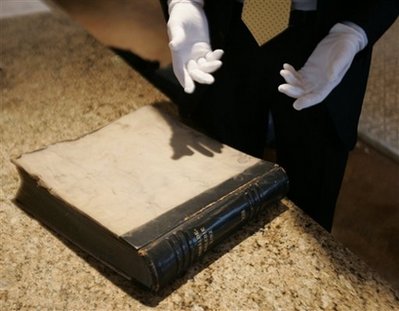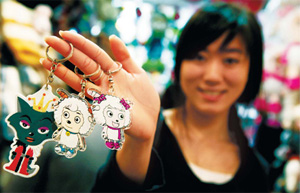Newsmaker
WWII veteran had Hitler's art book on bookshelf
(Agencies)
Updated: 2009-12-10 13:37
DALLAS: After fighting his way across Europe during World War II, John Pistone was among the US soldiers who entered Adolf Hitler's home nestled in the Bavarian Alps as the war came to a close.
|
 This Dec. 2, 2009 photo taken in Dallas shows a lost album that once belonged to Adolf Hitler, part of a series compiled for Hitler featuring photographs of art he wanted for his 'Fuehrermuseum,' a planned museum in Linz, Austria. [Agencies]
|
Making his way through the Berghof, Hitler's home near Berchtesgaden, Germany, Pistone noticed a table with shelves underneath. Exhilarated by the certainty of victory over the Nazis, Pistone took an album filled with photographs of paintings as a souvenir.
Sixty-four years after Pistone brought the album home to Ohio, the 87-year-old has learned its full significance: It's part of a series compiled for Hitler featuring art he wanted for his "Fuhrermuseum," a planned museum in Linz, Austria, Hitler's hometown.
Pistone's album is expected to be formally returned to Germany in a ceremony at the US State Department in January. Germany has 19 other albums discovered at the Berchtesgaden complex that are part of a 31-album collection of works either destined for or being considered for the Linz museum.
Pistone's 3-inch thick, 12-pound album's journey from obscurity began this fall when a friend became curious about the book sitting on Pistone's bookshelf.
The friend discovered after some Internet searching that the Dallas-based Monuments Men Foundation for the Preservation of Art was involved in 2007 in the restitution of two other albums that were part of a series documenting art stolen by the Nazis from Jewish families.
Its founder, Robert Edsel, who while living in Italy for a time after selling his oil and gas business became interested in what was done to protect art in World War II, traveled to Ohio this fall to examine Pistone's album. Seeing it convinced him that Pistone had one of the missing albums of the series on the planned museum.
Stamped on the album's spine is "Gemaldegalerie Linz" - Gemaldegalerie means picture gallery in German - and the Roman numerals for 13. It still has a sticker from the book's binder in Dresden.
Birgit Schwarz, a German art historian from Vienna who has written books about Hitler and art, including a book called "Hitler's Museum" describing the albums in the series, is convinced the album is authentic. She said she recognized paintings in the album along with the volume number and title.
"It's absolutely clear!" she wrote in an enthusiastic e-mail to the AP after reviewing scanned photographs of the album. "Hans Makart's 'Pest in Florenz' (Plague in Florence), for example, the first picture of album XIII, Hitler got as a gift from Mussolini!"
Souvenir hunting was routine by soldiers during the war, and problems arise when people try to sell rather than return culturally important items, said Thomas R. Kline, a Washington-based lawyer who specializes in art restitution and works for the foundation.
"It's really important that as people go through their attics and they find the things that grandpa brought home, people are aware that something as simple as a book of pictures could have a cultural significance," Kline said.
Ambassador J. Christian Kennedy, special envoy for Holocaust issues at the State Department, said the agency is happy to help return objects taken during the war. "This is all about doing the right thing," Kennedy said.
Edsel started his foundation in 2007 to honor and continue the work of the original Monuments Men, the roughly 345 men and women from 13 nations who helped Allied forces protect cultural treasures during World War II. After the war, they began trying to find the rightful owners of pieces of art looted by the Nazis, hundreds of thousands of which are still missing.
"It's my desire to see the works of the Monuments Men completed," said Edsel, who wrote two books detailing the group's work.
The discovery of albums could help. In Pistone's case, experts had the names of artwork featured in his album but the photographs could help match them to the correct piece of art, Edsel said.
"They are key documents from the crime scene," he said of the albums.
He said the art Hitler wanted for his museum was bought, stolen or confiscated. The 13th album contains works by some of Hitler's favorite German painters, including a photo of Adolf von Menzel's painting of Frederick the Great that hung in Hitler's office in Munich.
Edsel said his office gets about a call a day from someone curious about an item brought home after the war.
"We're looking for people with goodwill who don't know what they have," Edsel said.












